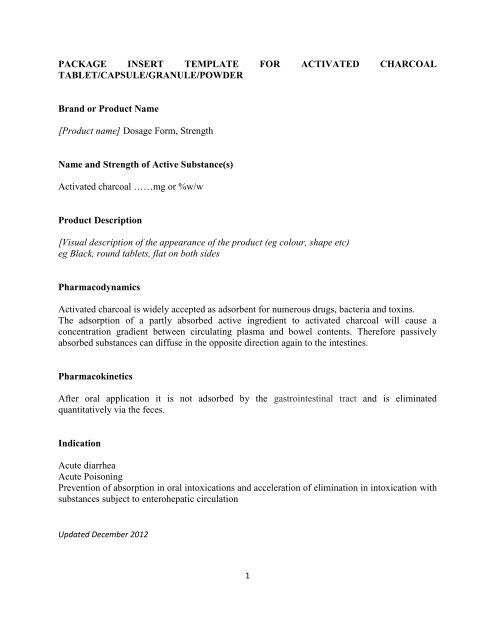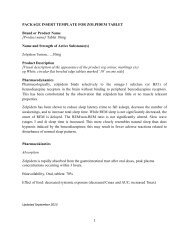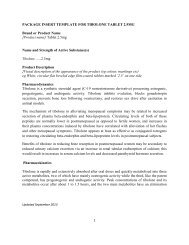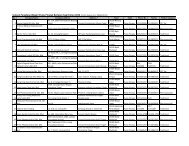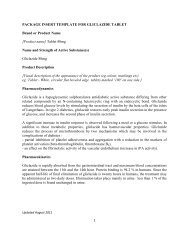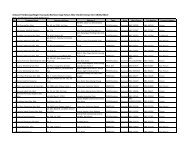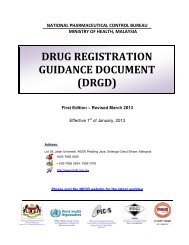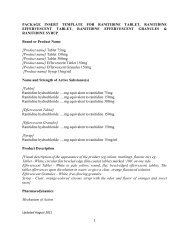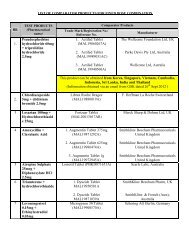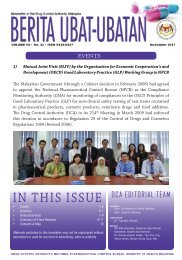PACKAGE INSERT TEMPLATE FOR ADAPALENE GEL - BPFK
PACKAGE INSERT TEMPLATE FOR ADAPALENE GEL - BPFK
PACKAGE INSERT TEMPLATE FOR ADAPALENE GEL - BPFK
- No tags were found...
Create successful ePaper yourself
Turn your PDF publications into a flip-book with our unique Google optimized e-Paper software.
<strong>PACKAGE</strong> <strong>INSERT</strong> <strong>TEMPLATE</strong> <strong>FOR</strong> ACTIVATED CHARCOALTABLET/CAPSULE/GRANULE/POWDERBrand or Product Name[Product name] Dosage Form, StrengthName and Strength of Active Substance(s)Activated charcoal ……mg or %w/wProduct Description[Visual description of the appearance of the product (eg colour, shape etc)eg Black, round tablets, flat on both sidesPharmacodynamicsActivated charcoal is widely accepted as adsorbent for numerous drugs, bacteria and toxins.The adsorption of a partly absorbed active ingredient to activated charcoal will cause aconcentration gradient between circulating plasma and bowel contents. Therefore passivelyabsorbed substances can diffuse in the opposite direction again to the intestines.PharmacokineticsAfter oral application it is not adsorbed by the gastrointestinal tract and is eliminatedquantitatively via the feces.IndicationAcute diarrheaAcute PoisoningPrevention of absorption in oral intoxications and acceleration of elimination in intoxication withsubstances subject to enterohepatic circulationUpdated December 20121
Recommended DosageTablets/ CapsulesDiarrhoea:Depending on the severity of the case, 400mg-1000mg is administered 3 – 4 times daily. Half ofthis dose is recommended for children.The medication should be taken on an empty stomach with plenty of liquid.The medication should be used until the stools have returned to normal if the patient has notresponded to treatment after about 3 days; other therapeutic or diagnostic measures must betaken.Intoxications:In acute intoxications, depending on the individual case, activated charcoal must be administeredin higher doses (0.5 – 1g/kg body weight).Adults receive 500mg-1000mg per kg body weight, children 200mg-500mg per kg per weight.In unconscious patients a doctor or a nurse under medical supervision, should administer thesuspension tablets in water by gastric tube.Administration may be repeated at intervals of 2 – 4 hours. Due to the risk of hyperchloraemiathe suspension should be given in isotonic saline or full electrolyte solution where multiple dosesare administered. It is recommended to additionally administer 1 tablespoonful (adults) or ½ - 1tablespoonful (children) of sodium sulfate (Glauber’s salt) in 1 glass of water 30 – 60 minuteslater. This saline laxative induces rapid intestinal passage. By this measure the poison, which isbound to the charcoal, is removed from the intestinal tract before part of the poisonoussubstances can be liberated. To accelerate elimination in intoxications with substances subject toenterohepatic circulation 200mg/1 – 2 kg body weight should be given. This measure can berepeated every 2 – 4 hours.Granules/ SuspensionAdults and children from 12 years of age:Activated charcoal is given orally or via a nasogastric tube usually as slurry in water. A usualdose for reduction of absorption is 50g, but higher doses (100 g) have been used. For maximumefficacy, activated charcoal should be given as soon as possible (within 1 hour) after ingestion ofthe toxic compound. For some drugs such as those that undergo enterohepatic or enteroentericrecycling (e.g. phenobarbital and theophylline) repeated doses of activated charcoal are of valueUpdated December 20122
in enhancing faecal elimination. Doses for repeated administration in active elimination havevaried but typically 50g may be given every 4 hours; 25g every 2 hours or 12.5 g hourly may bebetter tolerated, but efficacy may be affected.Children up to 12 years of age:Activated charcoal is used in children for the treatment of acute oral poisoning. For the reductionof absorption of poisons, a usual dose is 1g/kg (to a maximum of 50g) given orally or via anasogastric tube. This dose may be repeated every 4 hours for the active elimination of poisons.If vomiting is a problem, smaller amounts of charcoal given hourly or every 2 hours may causeless gastric irritation.Mode of AdministrationOralContraindicationsActivated charcoal is contraindicated in those patients with absence of bowel sounds, GIperforation, intestinal obstruction, recent surgery, risk of GI haemorrhage, febrile diarrhoea andhypersensitive to any other excipients.Warnings and PrecautionsWarnings:Activated Charcoal is not recommended for treatmentof diarrhoea in children under 6 years of ageActivated charcoal may interfere with the absorption of other drugs, including antibiotics, whenadministered concurrently.Precautions:Appropriate fluid and electrolyte therapy should be given to protect against dehydration. Oralrehydration therapy which is the use of appropriate fluids including oral rehydration saltsremains the most effective treatment for dehydration due to diarrhoea. The intake of as much ofthese fluids as possible is therefore imperative.Updated December 20123
Interactions with Other MedicamentsActivated charcoal has the potential to reduce the absorption of many drugs from thegastrointestinal tract and simultaneous oral therapy should therefore be avoided. In themanagement of acute poisoning, concurrent medication should be given parenterally.Care is needed if a specific oral antidote such as methionine is given since adsorption of theantidote may decrease its efficacy; it has been recommended that activated charcoal should becleared from the stomach or avoided if oral antidotes are to be used.The adsorptive capacity of activated charcoal may be reduced by food; larger doses of activatedcharcoal may be needed if a large meal was eaten before treatment.Statement on Usage During Pregnancy and LactationPregnancy and LactationAvailable evidence is inconclusive or is inadequate for determining foetal risk when used inpregnant women or women of childbearing potential and during breast feeding. Weigh thepotential benefits of drug treatment against potential risks before prescribing this drug duringpregnancy.Adverse Effects / Undesirable EffectsActivated charcoal is relatively non-toxic when given orally but gastrointestinal disturbancessuch as vomiting, constipation, or diarrhoea have been reported.It may colour the faeces, tongue, and mucous membranes black.Overdose and TreatmentUnknownStorage Conditions[eg Store below…. C ]Dosage Forms and Packaging Available[Packaging type & pack size]Updated December 20124
Name and Address of Manufacturer[Name & full address of manufacturer]Name and Address of Marketing Authorization Holder[Name & full address of marketing authorization holder]Date of Revision of Package Insert[day/month/year ]Updated December 20125


